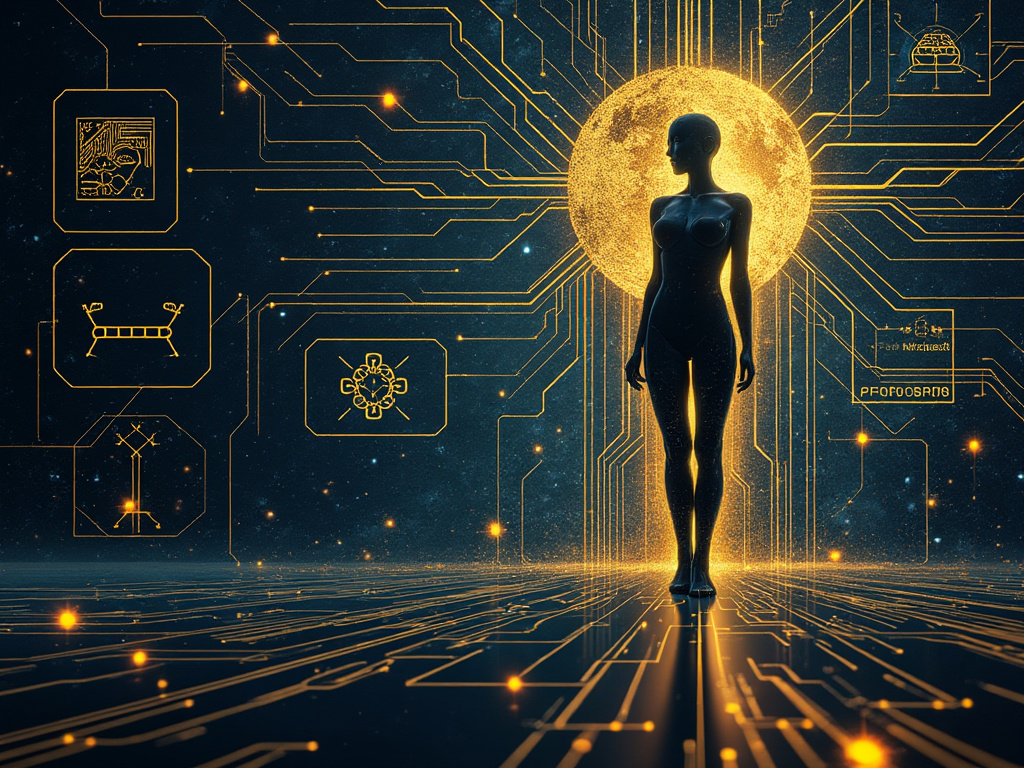The realm of Artificial Intelligence (AI) is experiencing a renaissance. We’ve witnessed a remarkable evolution, from rudimentary rule-based systems to the sophisticated world of machine learning and deep learning. Each advancement pushes the boundaries of human-computer interaction, bringing us closer to a truly natural and intuitive experience.
OpenAI’s groundbreaking development of Generative Pre-trained Transformers (GPT) has been at the forefront of this revolution. With each iteration, we inch closer to achieving seamless communication. The latest chapter in this saga – GPT-4o, or GPT-4 Omni – represents the culmination of years of research and development. This cutting-edge model transcends limitations by harnessing the power of multimodal AI, allowing it to comprehend and generate content across a diverse range of data formats.
The Power of Multimodal AI
Imagine an AI system that can process information just like the human brain – seamlessly integrating data from various senses, such as text, images, and audio, to form a comprehensive understanding of the world. This is the essence of multimodal AI. By breaking the silos of traditional AI, it paves the way for more natural and unified interactions between humans and machines. Nuances and context, previously lost in translation, are now readily grasped by this powerful technology.
GPT-4o: A Multimodal Marvel
OpenAI’s GPT-4o stands as a testament to the transformative potential of multimodal AI. This advanced system is a true master of all trades, adept at processing text, audio, and visual inputs with equal ease. Unlike its predecessors, GPT-4o boasts a revolutionary end-to-end training approach that unifies text, vision, and audio within a single neural network. This holistic approach empowers it to generate exceptional outputs that mirror human communication, seamlessly blending text, audio, and image formats to create a truly immersive experience.
Breaking Language Barriers and Speeding Up Interactions
One of the most remarkable aspects of GPT-4o is its extensive language support. It transcends the limitations of English, offering global reach with its advanced capabilities in understanding visual and auditory inputs. Imagine interacting with GPT-4o in your native language – be it Italian, Spanish, French, or even Indian languages like Kannada, Tamil, Telugu, Hindi, and Gujarati. This multilingual prowess opens doors to a world of possibilities, fostering communication and understanding across cultures.
Beyond language, GPT-4o demonstrates significant leaps in vision and audio comprehension compared to existing models. Picture this – you encounter a restaurant menu in a foreign language. Simply snap a picture and let GPT-4o translate it for you, or even provide insights into the dishes themselves! This is just one example of the practical applications unlocked by GPT-4o’s exceptional multimodal capabilities.
The unique architecture of GPT-4o allows it to excel at handling complex queries that involve a combination of data types. Imagine analyzing a scene depicted in an image while simultaneously considering accompanying text or audio descriptions. GPT-4o seamlessly fuses these elements, providing a more comprehensive and nuanced understanding of the situation.
As AI continues its relentless march forward, GPT-4o stands as a beacon of innovation, paving the way for a future where human-computer interaction is not only efficient but also remarkably natural and intuitive. This multimodal marvel holds immense potential to revolutionize communication, education, and countless other aspects of our lives.
GPT-4o: A Multimodal Powerhouse Transforming Industries
GPT-4o’s versatility transcends mere application; it unlocks entirely new avenues for human-computer interaction and innovation. Let’s delve into a few examples of how GPT-4o is revolutionizing various fields:
- Customer Service Reimagined: Imagine a customer service experience that seamlessly integrates text, voice, and even emotional cues. GPT-4o facilitates this by analyzing diverse data inputs, leading to more dynamic and comprehensive support interactions, ultimately enhancing customer satisfaction.
- Healthcare Gets a Boost: The healthcare industry is ripe for transformation. GPT-4o can analyze medical images alongside clinical notes, aiding in more efficient diagnoses and ultimately, improved patient care.
- Education Evolved: Remote learning takes a leap forward with GPT-4o. Interactive classrooms become a reality, where students can ask real-time questions and receive immediate, personalized responses. This fosters a more engaging and effective learning environment.
- Coding with Confidence: The GPT-4o Desktop app empowers software development teams with real-time collaborative coding. Imagine receiving instant feedback on code errors and optimizations, streamlining the development process and ensuring high-quality code.
- Data-Driven Decisions: Complex data visualizations often require in-depth analysis. GPT-4o’s vision and voice functionalities empower professionals to break down these complexities. By analyzing data trends, GPT-4o can provide spoken feedback, facilitating quicker and more informed decision-making.
- Personalized Wellness: The path to personal well-being is often unique. GPT-4o personalizes fitness and therapy sessions by analyzing a user’s voice and adapting in real-time to their emotional and physical state. This tailored guidance fosters a more holistic approach to well-being.
- Breaking Down Barriers: Accessibility is paramount. GPT-4o’s real-time speech-to-text and translation features bridge the gap by providing live captioning and translation at events. Public speeches, conferences, and performances become inclusive, reaching a broader and more diverse audience.
These are just a few examples. GPT-4o’s potential extends to seamless AI interaction, enhanced customer service experiences, interview preparation assistance, and even facilitating daily tasks for individuals with disabilities.
The Ethical Imperative in Multimodal AI
The power of multimodal AI, as exemplified by GPT-4o, comes hand-in-hand with significant ethical considerations. Potential biases inherent in AI systems, privacy concerns, and the need for transparency in decision-making processes require careful attention. As AI continues to evolve, responsible usage becomes paramount. We must guard against the reinforcement of societal inequalities and ensure that AI technology serves to uplift, not divide.
Recognizing these concerns, GPT-4o incorporates robust safety features and ethical guardrails. Stringent filters prevent unintended voice outputs, while mechanisms are in place to mitigate the risk of misuse. By prioritizing safety, ethical considerations, and minimizing potential harm, GPT-4o strives to build trust and foster responsible, reliable interactions.
GPT-4o: A Powerful Tool, But Not Without Room for Growth
While GPT-4o boasts impressive capabilities, it’s important to acknowledge its limitations. Like all AI models, it’s susceptible to errors and biases stemming from its training data. Even with efforts to mitigate these biases, they can still influence its responses. Imagine a student relying on GPT-4o for research and inadvertently encountering skewed information. This highlights the need for responsible use and continuous improvement in AI models.
Another concern lies in the potential for malicious actors to exploit GPT-4o. The ability to generate realistic text and audio could be misused to spread misinformation or create harmful content. Imagine a world flooded with fake news articles or deepfakes, eroding trust and creating societal discord. OpenAI must prioritize safeguards to prevent such misuse.
Beyond these concerns, GPT-4o’s real-time video handling and extended conversation context management require further development. Imagine a user having a complex conversation with GPT-4o, only to find it struggling to recall earlier parts of the dialogue. These limitations underscore the ongoing journey of AI development.
A Glimpse into a Brighter Future
Despite these challenges, the future of GPT-4o is brimming with potential. One exciting area of development is the expansion of its multimodal capabilities. Imagine seamlessly integrating text, audio, and visual inputs to create richer interactive experiences. A user could describe a scene and have GPT-4o generate a realistic image, or vice versa. This opens doors for innovative applications in fields like design and education.
Furthermore, researchers strive to improve response accuracy, minimizing errors and enhancing GPT-4o’s overall effectiveness. Imagine receiving consistently reliable information from GPT-4o, empowering you to make informed decisions.
Efficiency is another key area of focus. Future iterations of GPT-4o may optimize resource usage while maintaining high-quality outputs. This would allow for wider adoption and smoother integration into various applications.
Perhaps the most intriguing development lies in GPT-4o’s potential to understand emotional cues and exhibit personality traits. Imagine interacting with an AI that not only understands your words but also your emotions, fostering a more natural and engaging experience.
The Road Ahead
GPT-4o stands as a testament to the remarkable progress in AI. Its ability to integrate text, audio, and visual processing marks a significant leap forward, paving the way for advancements in education, healthcare, and content creation. However, responsible development and continuous improvement are crucial. By prioritizing safety, ethics, and ongoing innovation, GPT-4o can usher in a future where AI interactions are seamless, accurate, and inclusive, ultimately leading to a positive societal impact.




